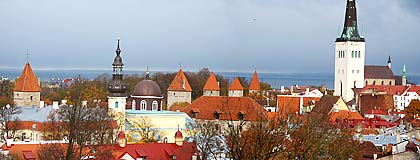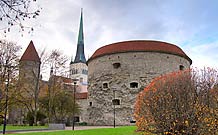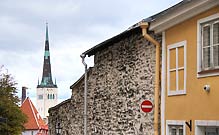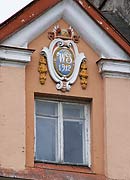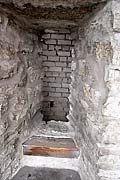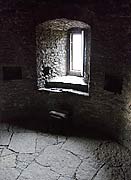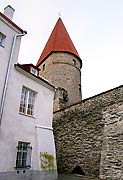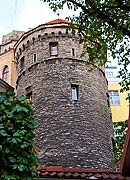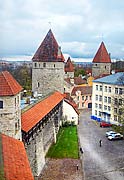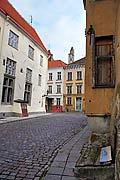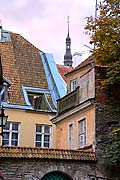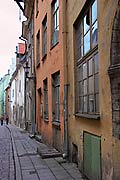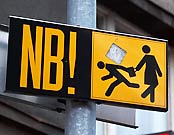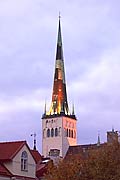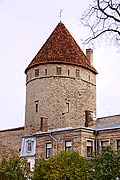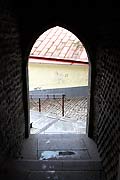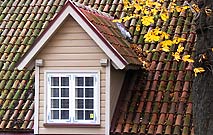Brief history of Tallinn
'This is a small city like a fortress - Quoluwany' - this is how the Arab geographer Al-Idrisi wrote about this city in 1154. This is the first mention of Tallinn that has survived to this day. Among the Slavs, there was a more common name Kolyvan, the Scandinavians and the Germans knew it as Reval. The Estonian self-name Tallinn (Taani linn) was first mentioned in 1536. The fortified Estonian village on the coastal hill of Tompea certainly existed long before all this.
Estonians resisted the crusaders from the Order of the Swordsmen longer than other Baltic peoples, but after the defeat at Viljandi (1217) and the invasion of the Danes under the leadership of Voldemar II (1219-1220) they were forced to surrender. In 1219, the Danes began to build a stone castle on the Tompea hill, which became the center of power in the conquered region. In 1229, its construction was generally completed.
In 1223 Yaroslav Vsevolodovich 'went to Kolyvan, and war fought the whole land of Chyud; but it is full, bringing innumerable but cann not take the city.' as Novgorod letopis say.
In 1346, the practical Danes sold their possessions in the country of the Estonians to the Teutonic Order, and they resold them to the Master of the Livonian Order a year later. Apparently, the medieval Estonians were quite quarrelsome people and did not allow the newcomers to relax especially, all the land was restless and problematic. No wonder the residence on Tompea (Vyshgorod) was separated from the rest of the city by a good fortress wall with a moat ...
The Livonians strengthened, rebuilt and improved city fortifications. In that time the castle acquired its current rectangular shape with 4 towers at the corners. In those days, the city consisted of the Upper City (Small Fortress - Toompea Castle and the Big Fortress) and the Lower City, whose inhabitant's relationship with the owners of the castle was not loyal and friendly ...
At the beginning of the XV AD Tallinn (then - Reval) entered the Hanseatic League and began its rapid economic growth and, as a result, large-scale urban construction, including fortifications. The castle fortifications were strengthened, new walls and towers appeared around the city, and the main tower of the castle 'Pikk Hermann' founded in the 1360s was completed to its current height - 95.6 meters.
Then the Livonian War began, the Livonian Order was defeated by Russia, the troops of Ivan the Terrible stormed Revel unsuccessfully, then Sweden and the Rzeczpospolita ventured into the division of the Livonian inheritance. All of it ended with the defeat of Russia, the Altmark Truce in 1629 and the partition of Livonia by the victorious powers.
Revel fell under the rule of the Swedish crown, however - the Swedes had ruled there since 1561, while they were mainly engaged in civil and industrial construction, not paying much attention to fortification as such due to lack of funds. During this period, the city experienced a great economic upsurge, the first manufactories and guild associations appeared, as well as a printing house, which in 1637 published the first ever book in Estonian.
In 1710 during the Great Northern War the city was besieged by the Russians and, after more than a month's siege, was forced to surrender due to hunger and lack of ammunition. The plague epidemic, which was not rare in those ugly days, was added to the disasters of wartime. Under the Russian rule, the castle and the city houses were left completely without care and gradually fell into decay, until Empress Catherine II in 1766 ordered them to be restored to their proper form and to equip the residence of the governor-general in the castle. In 1767-1773, for this purpose, the eastern wall of the fortifications on Tompea was dismantled and a baroque governor's palace was built there.
Subsequently no fortification construction was carried out in the city, only the old walls and towers were gradually dismantled for the needs of new urban construction. As part of the Russian Empire, Revel became a fairly significant merchant port city and the center of the Revel province.
After the proclamation of independent Estonia in 1918, the Estonian government was housed in the castle, and Revel became the capital of the new born state. In 1919 Revel was officially renamed to Tallinn. Having survived two economic crises 1920 and 1929-1933, the city and the country again began to get out of the ruin, taking advantage of the advantages of thefreedom state.
Everything would be fine, but according to the secret annex to the Moscow Treaty of 1939 between the USSR and Germany (so called Non-Aggression Pact), Estonia was included in the sphere of interests of the USSR. On August 6, 1940, as a result of a series of well-known events, this clause of the treaty was implemented and Estonia was annexed and become ESSR (Estonian Soviet Socialist Republic), and Tallinn, respectively, become the capital of the union republic.
During the Second World War, Tallinn was badly destroyed - in August 1941 during its defense by Soviet troops and in March 1944 during the bombing of the city by Soviet aviations. On September 22 of the same year, Tallinn was cleared of Germans invaders. So Tallinn became Soviet again until the 'Singing Revolution' of 1989, after which it again became the capital of independent Estonia and continues to be ...
Impressions
... and it was so. At Varshavsky railway station late in the evening I get into the so-called rigid reserved seat carriage with bare wooden shelves (I don't take a mattress with linen for 1 ruble, or tea for 10 kopecks - it's was expensive for me, since as much as 16 rubles were already spent on a ticket from Leningrad to Tallinn and back) ...
... this wagon smell, now this seems to be gone forever...
... the night, the carriage counts the rail's joints and jumps up hard, unceremoniously shoving on the switches ...
... in Tallinn before dawn - everything is allien: inscriptions in Latin letters, unfamiliar tram tickets that must be composted, 'terve' (hello - est.) and the subsequent alienation when I trying to buy a station 'boiler' coffee. Now I am an occupier, wearing well-worn sneakers and a wrinkled bologna jacket with 1 ruble 40 kopecks. in my pocket I arrived to this city and it's mine until the evening. In my head - an obsessive motive 'Tallinn mu-oi Tal-lin-nn, where-e-songs are sounds-at ...' (Estonian singer of 1980s Anna Veski).
It was such entertainment in Leningrad of the USSR era - a night in a hard reserved seat, and you seem to be in Europe ...
... and Europe still showed through inexorably, through dust, asphalt and Soviet plaster, though it looked like on the Soviet Svema film of the Shostka chemical plant ...
And now the Soviet past sometimes also appears, gradually disappearing and dissolving under a layer of new paint from the Finnish company Tikkurilla. Strange, but for some reason I do not regret at all ...
Now this is a Capital European city - renovation, chic, brilliance, cleanliness, neatness, political correctness - no Russophobia, at the word 'hello' - they smile, for 'terve' with a Russian accent it seems they are ready to kiss you ...
Had a very pleasant time. I ate at McDonadles, bought some clothes, spent a lot of money off my credit card. 'Vana Tallinn' was packed to capacity (there is at least something invariably beautiful in this filthy world). I made 4 GB of photos - the walls of the tower, streets, houses ...
Nevertheless - everything is so and not so, however - this is personal and has nothing to do with Tallinn ...
... and in winter it smelled of peat briquettes, which were used to heat the stoves in the old town. This is the brightest impression ...
Land forts and fortress:
Bip Castle Gatchina Ivangorod Izborsk Kexholm Kirillov Monastery Koporye Novgorod Pechorskiy Monastery Peter&Paul Fortress Porkhov Pskov Schlisselburg Staraya Ladoga Tikhvin Vyborg Hameenlinna Hamina Kastelholm Kymenlinna Lappaenranta Raseborg Castle Savonlinna Tavetti Turku Visby Fredrikstadt Fredriksten Hegra Fort Hoytorp Fort Arensburg Narva Tallinn Antipatris Caesarea Jerusalem Latrun Fort Masada
Sea forts and fortresses:
Alexander Fort Ino Fort Krasnaya Gorka Fort Kronstadt: Kotlin isl. Kronstadt: North Forts Kronstadt: South Forts Trongsund Hanko Svartholm Sveaborg Marstrand Siaro Fort Vaxholm Oscarsborg
Artillery batteries and individual guns:
Coastal Artillery Hemso Fort
Fortified areas and defensive lines:
Karelian Fortified Area (KaUR) KrUR Leningrad Mannerheim Line Nevsky Bridgehead VT Line Harparskog Line Salpa Line Gothland
Russian
S e a r c h All news

